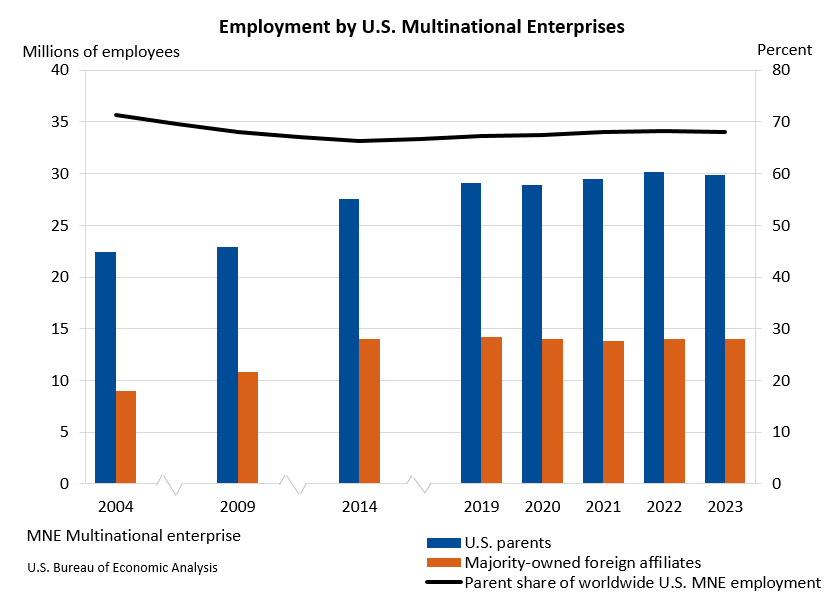Bureau of Economic Analysis
Activities of U.S. Multinational Enterprises, 2023
Worldwide employment by U.S. multinational enterprises decreased 0.4 percent to 43.9 million workers in 2023 (preliminary) from 44.1 million workers in 2022 (revised), according to statistics released today by the U.S. Bureau of Economic Analysis on the operations and finances of U.S. parent companies and their foreign affiliates.
Principal Federal Economic Indicators
Noteworthy
- 2025 News Release Schedule
- Innovation at BEA
- 2025 Annual Updates
- Distribution of Personal Income Nowcast
- New! Services Trade Data for More Countries
- Data Tool: Trade in Value Added
- Updated: RIMS II Regional Multipliers
- Arts and Culture
- Space Economy
- FDI Now in State BEARFACTS
- Quick Guide: Price Indexes
The Latest
Personal Consumption Expenditures by State, 2018
State personal consumption expenditures (PCE) increased 5.1 percent in 2018, an acceleration from the 4.4 percent increase in 2017. The percent change in PCE across all states ranged from 7.3 percent in Utah to 3.6 percent in West Virginia.
Personal Consumption Expenditures by State, 2018
State personal consumption expenditures (PCE) increased 5.1 percent in 2018, an acceleration from the 4.4 percent increase in 2017. The percent change in PCE across all states ranged from 7.3 percent in Utah to 3.6 percent in West Virginia.
U.S. International Investment Position Second Quarter 2019
The U.S. net international investment position, the difference between U.S. residents’ foreign financial assets and liabilities, was –$10.56 trillion at the end of the second quarter of 2019, according to statistics released by the U.S. Bureau of Economic Analysis (BEA). Assets totaled $28.01 trillion and liabilities were $38.56 trillion. At the end of the first quarter, the net investment position was –$10.16 trillion.
U.S. International Investment Position, Second Quarter 2019
The U.S. net international investment position, the difference between U.S. residents’ foreign financial assets and liabilities, was –$10.56 trillion at the end of the second quarter of 2019, according to statistics released by the U.S. Bureau of Economic Analysis (BEA). Assets totaled $28.01 trillion and liabilities were $38.56 trillion. At the end of the first quarter, the net investment position was –$10.16 trillion.
Real Disposable Personal Income Rises in August
Personal income increased 0.4 percent in August after increasing 0.1 percent in July. Wages and salaries, the largest component of personal income, increased 0.6 percent in August after increasing 0.2 percent in July.
Personal Income and Outlays, August 2019
Personal income increased 0.4 percent in August after increasing 0.1 percent in July. Wages and salaries, the largest component of personal income, increased 0.6 percent in August after increasing 0.2 percent in July.
GDP Increases in Second Quarter
Real gross domestic product (GDP) increased 2.0 percent in the second quarter of 2019, according to the “third” estimate released by the Bureau of Economic Analysis. The growth rate was the same as in the “second” estimate released in August. In the first quarter, real GDP rose 3.1 percent.
Gross Domestic Product, Second Quarter 2019 (Third Estimate); Corporate Profits, Second Quarter 2019 (Revised)
Real gross domestic product (GDP) increased 2.0 percent in the second quarter of 2019, according to the “third” estimate released by the Bureau of Economic Analysis. The growth rate was the same as in the “second” estimate released in August. In the first quarter, real GDP rose 3.1 percent.
State Personal Income, Second Quarter 2019
State personal income increased 5.4 percent at an annual rate in the second quarter of 2019, a deceleration from the 6.2 percent increase in the first quarter. The percent change in personal income across all states ranged from 7.5 percent in Texas to unchanged in North Dakota.
State Personal Income, Second Quarter 2019
State personal income increased 5.4 percent at an annual rate in the second quarter of 2019, a deceleration from the 6.2 percent increase in the first quarter. The percent change in personal income across all states ranged from 7.5 percent in Texas to unchanged in North Dakota.




